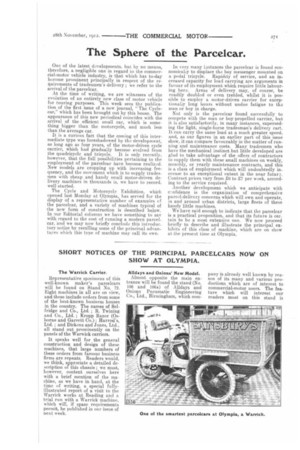The Sphere of the Parcel car.
Page 5

If you've noticed an error in this article please click here to report it so we can fix it.
One of the latest d.!velopments, but by no means, therefore, a negligible one in regard to the commermal-motor vehicle industry, is that which has to-day become prominent principally in respect of the requirementa of tradesmen's delivery ; we refer to the arrival of the parcelcar.
At the time of writing, we are witnesses of the evolution of an entirely new class of motor vehicle for touring purposes. This week sees the publication of the first issue of a new journal, "The Cyclecar," which has been brought out by this house. The appearance of this new periodical coincides with the arrival of the efficient small car, which is something bigger tha,n the motorcycle, and much less than the average car.
It is a curious fact that the coming of this intermediate type was foreshadowed by the development, as long ago as four years, of the motor-driven cycle carrier, which had gradually become evolved froni
the quadricycle and tricycle. It is only recently, however, that the full possibilities pertaining to the employment of the pareelear have become realized. New models are cropping up with increasing frequency, and the movement which is to supply tradesmen with cheap and handy small motor-driven delivery machines in thousands is, we have to record, well started.
The Cycle and Motorcycle Exhibition, which opened last Monday at Olympia, has served for the display of a representative number of examples of the parcelcar, and a variety of machines typical of the new form of construction is described below. In our Editorial columns we have something to say with regard to the cost, of running a modern parcelcar, and we may now briefly conclude this introductory notice by recalling some of the principal advantages which this type of machine may call its own. In very many instances the parcelcar is found economically to displace tha boy messenger mounted on
a pedal tricycle. Rapidity of service, and an increased capacity for load carrying are arguments in favour of its employment which require little labouring here. Areas of delivery may, of course, be readily doubled or even trebled, whilst it is possible to employ a motor-driven carrier for exceptionally long hours without undue fatigue to the man or boy in charge.
Not only is the parcelcar found successfully to compete with the man or boy-propelled carrier, but it is also satisfactorily, in many instances, superseding the light, single-horse tradesman's delivery cart. It can carry the same load at. a much greater speed, and, as our figures in an earlier part of this issue show, it can compare favourably in the matter of running and maintenance costs. Many tradesmen who have the mechanical instinct but little developed are glad to take advantage of the offers of contractors to supply them with these small machines on weekly, monthly, or yearly maintenance contracts, and this is a class of employment which will undoubtedly increase to an exceptional extent in the near future. Contract prices vary from Le to £7 per week, according to the service required.
Another development which we anticipate with confidence is the organization of comprehensive parcel-delivery concerns which will own and operate, in and around urban districts, large fleets of these handy little machines.
We have said enough to indicate that the parcelcar is a practical proposition, and that its future is certain to be a most extensive one. We now proceed briefly to describe and illustrate the principal exhibits of this class of machine, which are on show at the present time at Olympia.






















